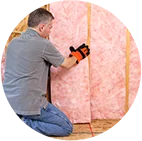Do you need to install insulation in a new home or re-insulate your existing home? It’s a good idea to know your options before even talking to a professional insulation company. This will make communication easier – and you’ll be less confused about insulation and how it works!
There are a number of different insulation materials – the one you use (and how much you install) will depend on factors such as:
- Where you need to insulate
- Whether or not it’s a new construction or retrofit project
- Where you live
- How old your home is
- And more
Different Types of Insulation Materials
The different types of insulation materials include:
Fiberglass
Fiberglass insulation is one of the types of insulation that’s been around the longest. It’s the pink fluffy stuff you’ve probably seen behind your walls or in the attic. It can be either a blanket system (rolls and batts) or loose-fill/blown-in.
Method: Fiberglass insulation traps heat in its fibers (stops conductive heat flow)
Location: Fiberglass insulation can be installed anywhere – attic floors, walls, crawl spaces and interior and exterior walls
Cellulose
Made of up to 80 percent recycled material, cellulose insulation is one of the most environmentally friendly types of insulation available. Cellulose insulation is also one of the best types of insulation to use for soundproofing.
Method: Like fiberglass, cellulose insulation stops conductive heat transfer
Location: Cellulose insulation can be installed in exterior and interior walls, attics and crawl spaces.
Foam
Foam insulation has a couple different forms – you can install spray foam or rigid board. Rigid board is typically used for new homes and is superior at reducing noise.
Method: Rigid board stops conductive heat transfer, and spray foam stops convective heat flow (air).
Location: Foam insulation is usually installed in the walls of your home.
Radiant Barrier
Reflective or radiant barrier insulation hasn’t been around as long as fiberglass insulation, but it has quickly become one of the most popular types of insulation. It works differently than fiberglass, cellulose and foam.
Method: Reflective insulation stops radiant heat.
Location: Radiant barrier insulation is installed in attics, right under the roof. It helps reflect heat from the sun, keeping your home a lot cooler and more comfortable.
If you need insulation contractors in Southern California, OJ Insulation has you covered. Now that you know a little bit more about the different types of insulation, you can talk to our insulation experts to figure out which type you need and where you need to insulate.
Contact us today for a FREE estimate!









